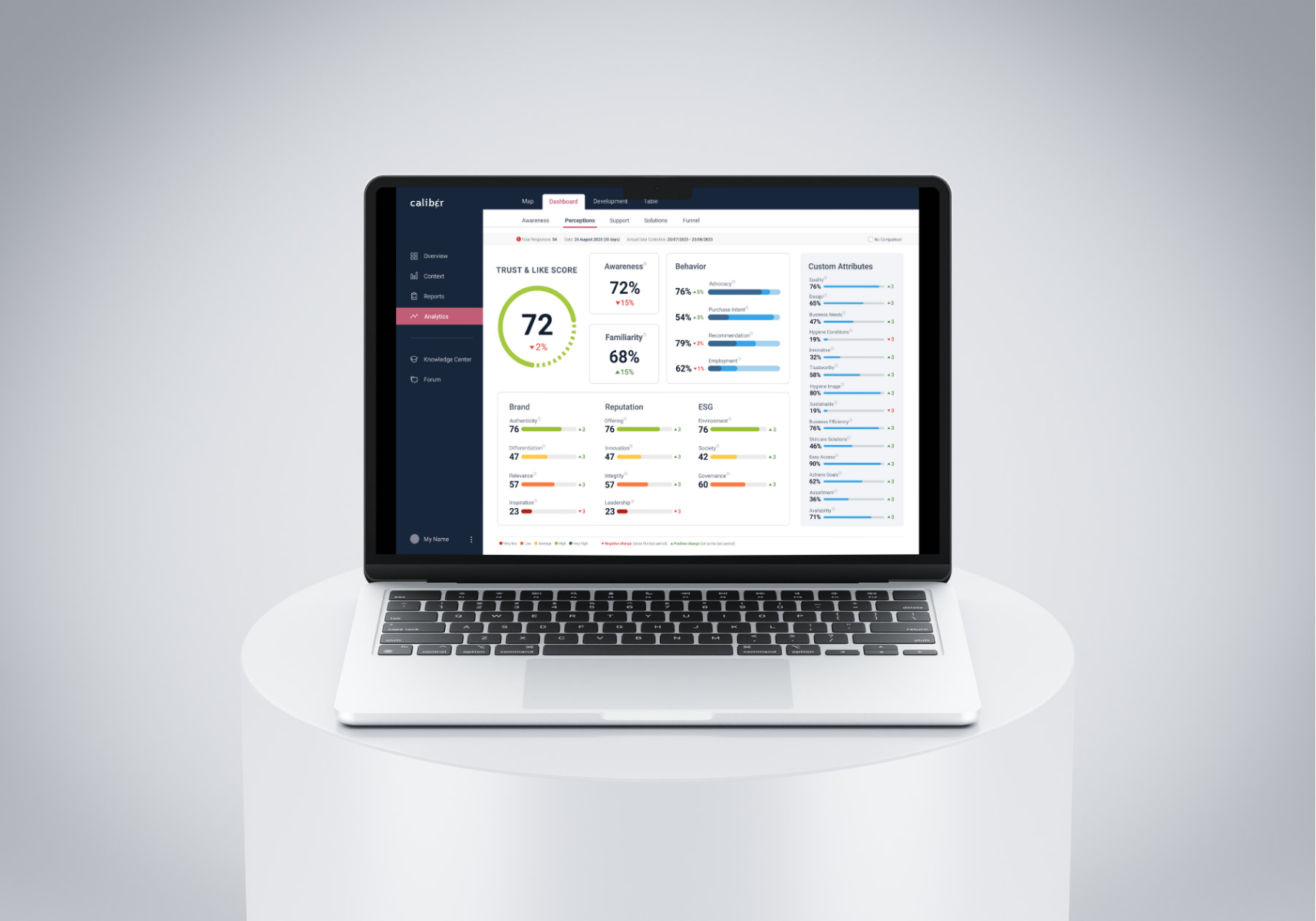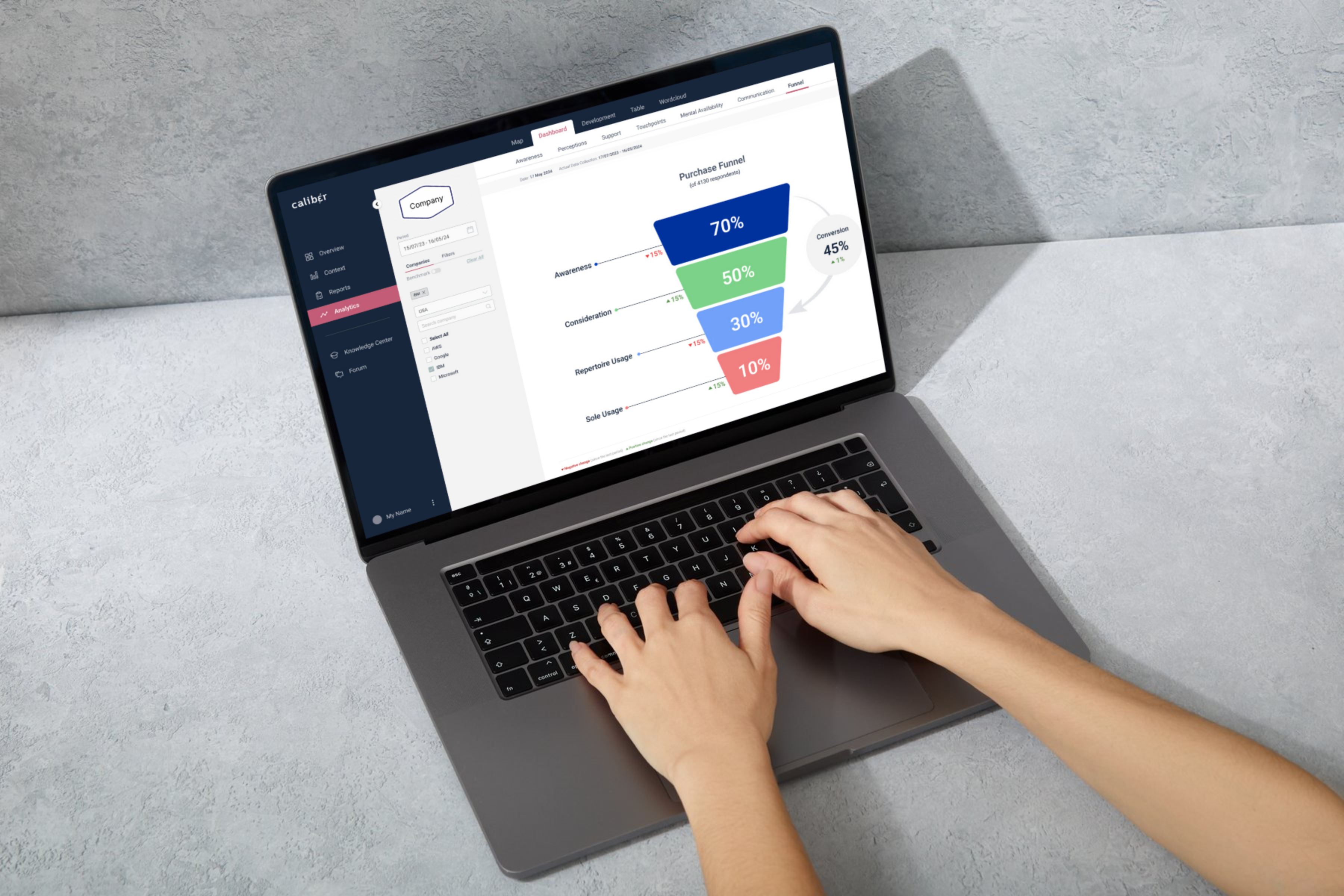In today’s always-on, hyper-connected, multi-stakeholder world, brand tracking has never been more important for businesses. But knowing how to do it well could be the difference between having a brand that’s bolstered — and one that’s busted.
We’ll explain what every business needs to know about brand tracking — what it is, why it’s important and the biggest mistakes organizations make when tracking their brand.
We’ll also discuss why tracking your brand and reputation in real time — and being able to get unique insights from specific stakeholder groups — is critical in this day and age.
Brand tracking is a systematic approach used by businesses to measure and analyze the health and performance of their brand over time.
It involves collecting data on various brand-related metrics, such as brand awareness, perception, loyalty, and overall brand equity. The goal is to understand how a brand is perceived by its target audience and how these perceptions change over time.
Brand tracking helps companies to stay informed about their brand’s position in the market, identify potential issues, and make data-driven decisions to enhance their brand strategy.
By regularly monitoring brand performance, businesses can ensure that their marketing efforts are effective and align with their brand goals.
Brand tracking connects your marketing activity to real shifts in awareness, perception, and loyalty. This allows you to evaluate the impact of campaigns beyond surface-level metrics and understand which messages, channels, or investments are contributing to measurable brand growth.
Tracking your brand alongside competitors helps you understand your relative position in the market. You can see where others are outperforming you, where you have a distinct advantage, and where white-space opportunities exist—insights that are difficult to uncover by looking at your brand in isolation.
With consistent brand data at your fingertips, strategic decisions become less subjective. Whether you’re refining positioning, reallocating budget, or planning future campaigns, brand tracking ensures your choices are grounded in how the market actually perceives your brand—not internal assumptions.
Surveys are one of the most common methods used in brand tracking. They involve collecting data from a sample of the target audience to measure various brand-related metrics.
Pros:
Cons:
Focus groups involve gathering a small group of people to discuss and provide feedback on a brand. This method is useful for gaining qualitative insights into brand perception and customer attitudes.
Pros:
Cons:
Social media monitoring involves tracking brand mentions and sentiment on social media platforms. This method provides real-time insights into how a brand is perceived online.
Pros:
Cons:
Tracking specific brand health metrics, such as Net Promoter Score (NPS) and Customer Satisfaction (CSAT), provides quantitative data on brand performance.
Pros:
Cons:
Tracking specific brand health metrics, such as Net Promoter Score (NPS) and Customer Satisfaction (CSAT), provides quantitative data on brand performance.
Pros:
Cons:
The frequency of brand tracking surveys depends on various factors, including the industry, market dynamics, and specific business goals. However, here are some general guidelines:
Conducting brand tracking surveys on a quarterly basis allows businesses to monitor changes in brand perception and performance regularly. This frequency is suitable for industries with fast-changing markets or frequent marketing activities.
Biannual surveys provide a balanced approach, allowing businesses to track brand performance twice a year. This frequency is suitable for most industries and provides enough data to identify trends and make informed decisions.
Annual surveys are less frequent but still valuable for tracking long-term brand performance. This frequency is suitable for industries with stable markets or limited marketing activities.
For businesses that require continuous insights, real-time brand trackers can provide up-to-date data on brand performance. While this approach has long been suitable for industries with high volatility or frequent brand-related events, in today’s always-on, hyper-connected and multi-stakeholder world, all organizations need real-time data and insights.

Brand tracking involves collecting data on various brand-related metrics over time to measure and analyze brand performance. It focuses on understanding long-term trends and changes in brand perception, awareness, and loyalty.
Brand monitoring, on the other hand, involves real-time tracking of brand mentions and sentiment across various channels, such as social media, online reviews, and news articles. It focuses on capturing immediate feedback and identifying potential issues as they arise.
Key differences:
Time Frame: Brand tracking focuses on long-term trends, while brand monitoring provides real-time insights.
Data Sources: Brand tracking typically relies on surveys and other structured data collection methods, while brand monitoring uses unstructured data from online sources.
Purpose: Brand tracking aims to measure overall brand health and performance, while brand monitoring aims to identify and address immediate issues.
Measures how well-known a brand is among its target audience. High brand awareness indicates strong market presence and visibility.
Assesses how customers perceive a brand in terms of attributes such as quality, reliability, and trustworthiness. Positive brand perception is crucial for building customer loyalty.
Measures the degree of customer loyalty to a brand, often assessed through metrics such as Net Promoter Score (NPS) and Customer Satisfaction (CSAT). High brand loyalty indicates strong customer retention and advocacy.
Evaluates the overall value of a brand, considering factors such as brand awareness, perception, and loyalty. High brand equity reflects a strong, valuable brand.
Assesses the likelihood that customers will purchase a brand’s products or services. High purchase intent indicates strong demand and market potential.
Brand tracking can measure brand awareness and provide insights into how well-known a brand is among its target audience.
By tracking brand perception, businesses can understand how customers view their brand in terms of quality, reliability, and trustworthiness.
Brand tracking can assess customer loyalty through metrics such as Net Promoter Score (NPS) and Customer Satisfaction (CSAT).
By monitoring changes in brand awareness, perception, and loyalty, businesses can determine the effectiveness of their marketing campaigns.
Brand tracking allows businesses to conduct competitive analysis and understand their brand’s positioning relative to competitors.
Having explored the importance of brand tracking per se, let’s consider the particular importance of brand tracking and reputation monitoring in real time — and take a look at Caliber’s two powerful platforms for brand tracking and reputation monitoring, Caliber 360 and Caliber Focus.
Tracking your brand and monitoring your reputation in real time allows you to get continuous insights about what relevant audiences think and how they’re likely to behave — anytime, anywhere.
Organizations that use a brand tracking and reputation monitoring platform can:
Caliber’s Real-Time Tracker is a cutting-edge solution for brand tracking by providing continuous, real-time data on brand performance. Unlike traditional surveys that may provide outdated information, Caliber’s platform ensures that businesses have up-to-date insights into brand awareness, perception, and loyalty.
1. Comprehensive Data
Caliber’s Real-Time Tracker collects data from various sources, including social media, online reviews, and news articles, providing a comprehensive view of brand performance.
2. Actionable Insights
The platform delivers actionable insights, allowing businesses to make informed decisions and adjust their branding and marketing strategies in real time.
3. Customizable Surveys
Caliber’s platform offers customizable surveys, enabling businesses to tailor their research questions and gather specific data relevant to their brand goals.
4. Competitive Analysis
With Caliber’s Real-Time Tracker, businesses can conduct competitive analysis and benchmark their brand performance against competitors, identifying opportunities for growth and improvement.
5. Early Issue Detection
The real-time nature of Caliber’s platform allows businesses to detect potential issues early and take proactive measures to address them, mitigating any negative impact on brand reputation.
6. Enhanced Decision-Making
By providing continuous, up-to-date data, Caliber’s Real-Time Tracker enhances decision-making, ensuring that businesses can respond quickly to changes in brand perception and market dynamics.
7. Building Stakeholder Trust
Caliber’s platform helps businesses to build and maintain stakeholder trust by ensuring transparency and responsiveness in their branding and marketing efforts.
In conclusion, Caliber’s Real-Time Tracker is a powerful tool for enhancing brand tracking. By providing continuous, real-time insights, the platform helps businesses to stay informed, make data-driven decisions, and build a strong, resilient brand.
In the next section, we’ll take a closer look at the two versatile versions of Caliber’s Real-Time Tracker — Caliber 360 and Caliber Focus.
Caliber’s Real-Time Tracker comes in two versatile versions — and can easily be combined — meaning that Caliber has a solution for every organizational need.
Caliber 360, which we explore in more detail below, is ideal for organizations that want to understand their entire stakeholder universe. It measures the full range of stakeholder perceptions, giving organizations a birdseye view of how its brand is perceived.
By contrast, Caliber Focus allows organizations to drill down into a specific issue or stakeholder group. That makes it ideal for tracking a single set of stakeholders such as customers, investors or potential employees.
Caliber Focus also allows organizations to get answers to specific questions about how its brand is perceived — in other words, how certain stakeholders think about it and behave towards it. It is, in short, perfect for tracking brand health and understanding stakeholders better.
Unlike social listening, Caliber’s Real-Time Tracker offers deep-dive analysis with expert commentary and access to multiple stakeholder groups
Unlike traditional market research, the Real-Time Tracker provides real-time data, instant alerts about reputation score, and the ability to sStart tracking new markets in minutes.
Unlike both social listening and market research, the Real-Time Tracker allows organizations to benchmark themselves against peers and sectors, combine media and perception data, and boost the sample size and run quick polls.

The original version of Caliber’s powerful Real-Time Tracker, Caliber 360 is ideal for organizations that want complete oversight of their stakeholder universe when tracking their brand and monitoring their reputation.
Why use Caliber 360 for brand tracking and reputation monitoring?
Using Caliber 360, organizations can monitor what relevant stakeholders think and get a broad overview of their brand and reputation among the people that matter most — including customers, employees, investors and the general public.
When facing a public relations crisis, an organization can use Caliber 360 to gauge the true impact of the crisis on its brand and reputation, and track the efficacy of its crisis communications and response.
Organizations can use Caliber 360 to understand the baseline perceptions and behaviors of all relevant stakeholders in a potential new market and use those insights to inform its entry strategy.
Using Caliber 360, organizations can get high-level insights into stakeholder perceptions and behaviors which they can use in the corporate social responsibility (CSR) section of their annual report.
Organizations that use Caliber 306 can track stakeholder perceptions in real time and measure the true impact of internal activities and external events on their brand and reputation, as well as on people’s engagement as customers, advocates or potential employees.
Using Caliber 360, organizations get real-time data and insights that can help them make better decisions, improve their corporate messaging and develop better branding, marketing and communications strategies.
Caliber 360 is a comprehensive brand and reputation tracking platform that provides continuous data and actionable insights and elegantly displays them on a user-friendly dashboard, all in real time.
Based on thousands of daily interviews worldwide, Caliber 360 is always-on, making it more effective than alternative solutions.
Caliber 360’s results are more accurate than periodic and point-in-time research.
The platform’s real-time data reflects a true picture in a dynamic environment.
Caliber 360 allows organizations to pivot and adapt as needed by adding custom metrics, benchmarks and issues.
The platform can be integrated into organizational dashboards via its API capability, with data from other sources easily imported.
Via automated online daily interviews, the platform continuously surveys thousands of people worldwide, providing timely and accurate data.
By tracking stakeholders in real time, Caliber 360 can tell organizations what they think of their business and how they’re likely to behave — anytime, anywhere.
Organizations can use data gathered in real time to anticipate threats, mitigate crises and seize opportunities.
Real-time brand tracking provides immediate insights into brand performance, allowing businesses to respond quickly to changes in brand perception and market dynamics.
By monitoring brand mentions and sentiment in real-time, businesses can identify potential issues early and take proactive measures to address them before they escalate.
Real-time data enables organizations to make timely, data-driven decisions, ensuring that their branding and marketing efforts are aligned with current market conditions and customer expectations.
Real-time brand tracking allows businesses to engage with customers promptly, addressing their concerns and feedback, and building stronger relationships.

In general, there are three key distinctions between Caliber Focus and other types of brand trackers.
1. Aided and unaided awareness
Caliber Focus allows organizations to track stakeholder awareness of their product or brand — with or without assistance.
2. Product brand tracking
It allows organizations to measure stakeholder perceptions of a particular product and understand what motivates them to consider, buy, remain loyal to or advocate for it.
3. Understanding stakeholders
Caliber Focus enables organizations to monitor — and understand — the motives, preferences and decisions of specific stakeholders such as customers, prospects, investors or potential employees.
Beyond these applications, there are specific use cases for brand tracking with Caliber Focus.
Organizations can use it to understand how clients and prospects perceive their brand and service quality and get detailed insights into the perceptions, preferences and satisfaction levels of specific decision-makers within client organizations.
Organizations can use it to understand how customers/users and prospects perceive their brand and get detailed insights into the perceptions, preferences and satisfaction levels of specific demographic sub-groups.
Data and insights from Caliber Focus can help strengthen an organization’s brand health and attract top talent by targeting specific professional sub-groups and getting detailed insights into their perceptions, preferences, and industry trends
Data and insights can be used to improve employee satisfaction and retention by gathering in-depth insights into an organization’s workforce’s perceptions and attitudes.
Businesses can enhance their communication with investors by understanding their concerns and preferences, enabling more tailored and effective engagement strategies
Companies can use Caliber Focus to understand the detailed perceptions and attitudes of specific, affected stakeholder groups and effectively manage their crisis response and communications.
It has never been more important for organizations to track the health of their brand and monitor stakeholder perceptions.
But traditional tools such as periodic market research lack immediacy, while newfangled ones such as social listening and media monitoring lack accuracy and subtlety.
Caliber’s Real-Time Tracker is the world’s most powerful online tool for continuously monitoring stakeholders.
Caliber 360 is ideal for organizations looking to monitor perceptions of their corporate reputation among their entire stakeholder universe.
Caliber Focus is perfect for organizations that want to track what particular groups of stakeholders think of their brand.
In combination, the two are the gold standard of reputation monitoring and brand tracking — and should be in the business intelligence arsenal of every forward-thinking enterprise.

James is a communications strategist and senior content lead at Caliber, where he writes about corporate reputation, stakeholder intelligence, and brand trust. He draws on more than a decade of experience helping organizations turn data into stories that build credibility and connection.
You may also be interested in
Follow Caliber
Get the results of our latest research directly in your inbox!
Brand tracking continuously measures how stakeholders perceive and engage with your brand over time. Caliber’s model connects rational perceptions (Reputation), attitudinal perceptions (Brand), and emotional response (Trust & Like) to predict stakeholder behavior. This helps you see not only what people think of your company, but why — and how those perceptions influence actions like buying, recommending, or investing.
Costs vary widely depending on how the tracker collects data, how many markets you include, and how often results are updated. Traditional research models can range from tens to hundreds of thousands per year due to manual studies and slow turnaround times. Modern platforms like Caliber offer real-time tracking at a fraction of that cost, with flexible pricing that scales with your sample size and market coverage.
Use your brand tracker as a decision tool, not just a data source. Check results regularly, connect changes in perception to your communication activities, and act quickly when scores shift. With Caliber, you can segment stakeholders, track campaign impact in real time, and benchmark against competitors — turning continuous insights into smarter, faster decisions.
Costs vary widely depending on how the tracker collects data, how many markets you include, and how often results are updated. Traditional research models can range from tens to hundreds of thousands per year due to manual studies and slow turnaround times. Modern platforms like Caliber offer real-time tracking at a fraction of that cost, with flexible pricing that scales with your sample size and market coverage.
For global brands, consistency and comparability are key. You need standardized metrics that capture perceptions across markets while reflecting local realities. Caliber’s real-time tracker is built for this — providing one global framework to measure trust, reputation, and brand performance across countries, audiences, and time. It allows you to benchmark results, spot regional differences, and manage your brand reputation globally with consistent, comparable data delivered in one platform.